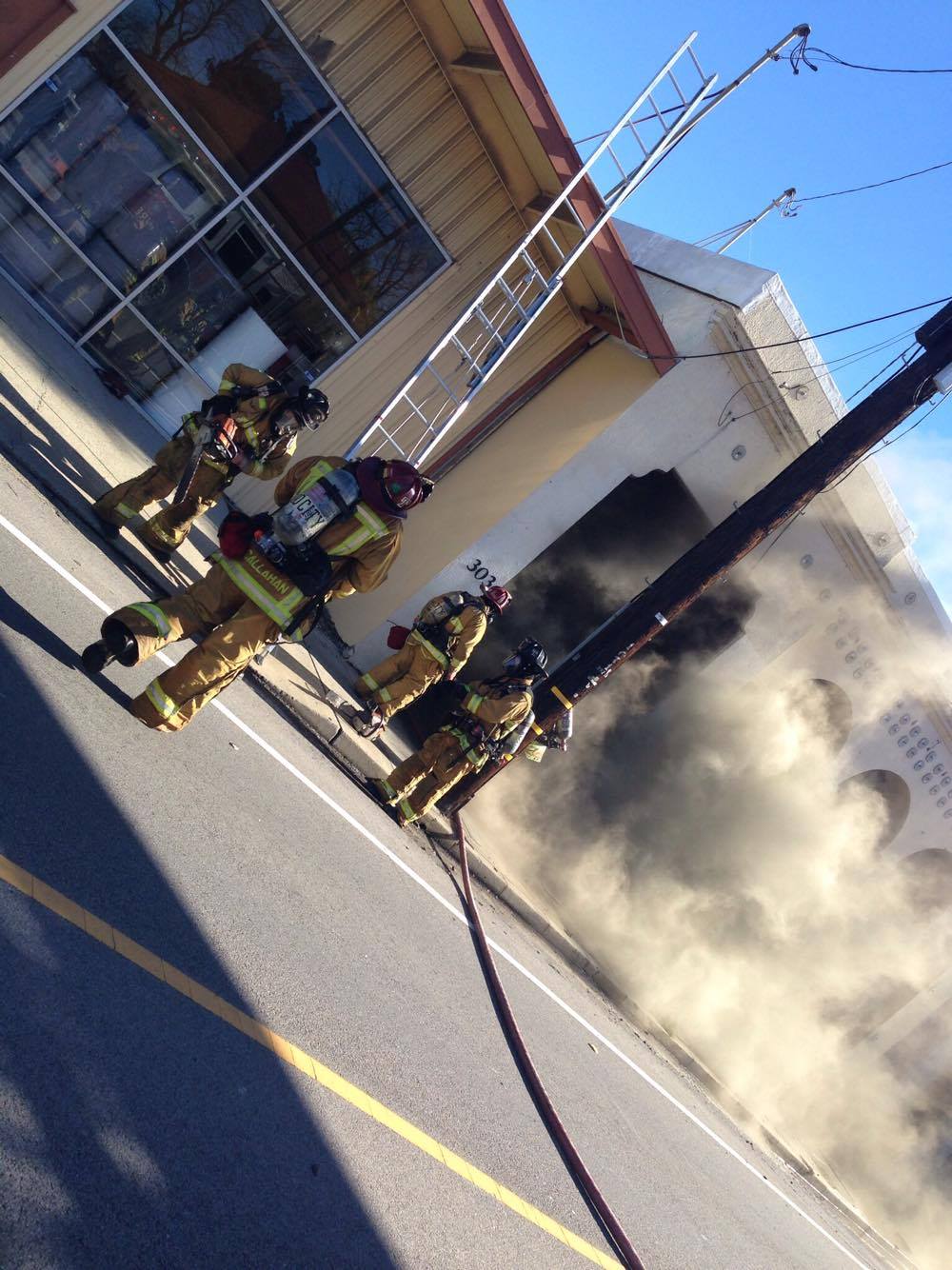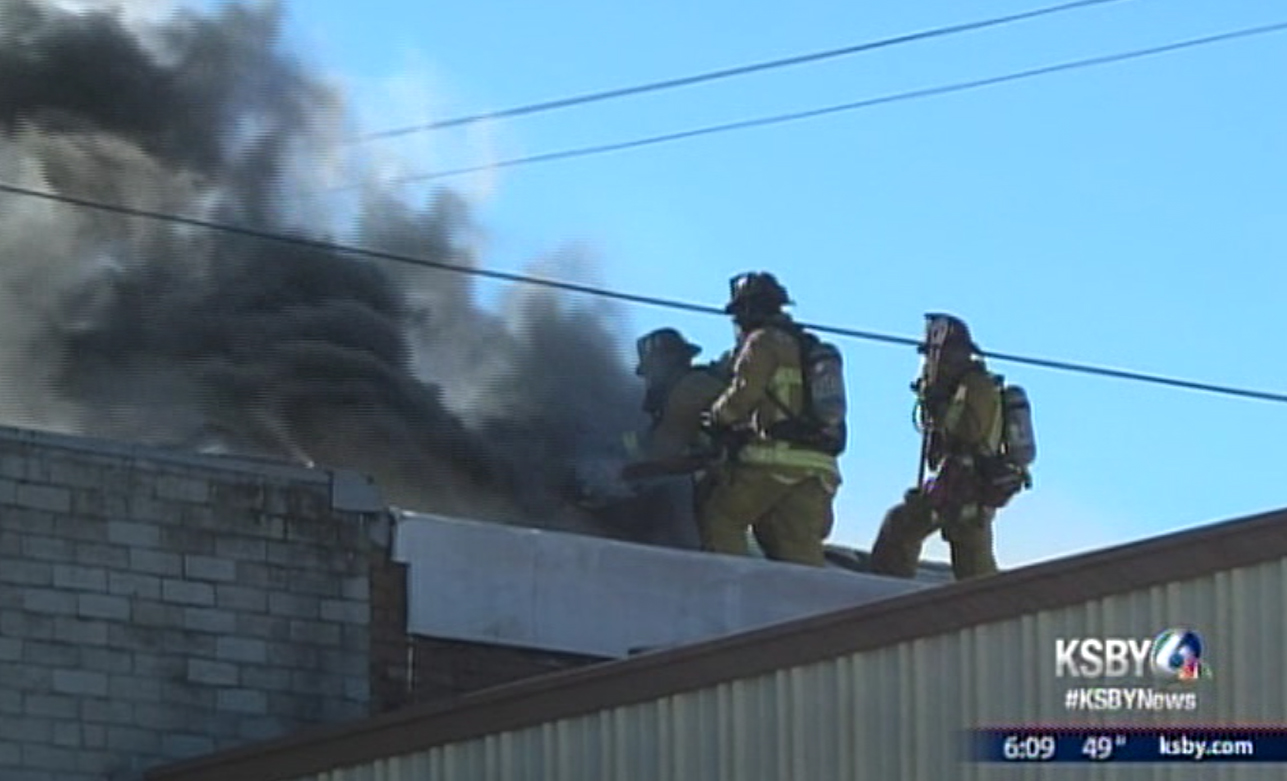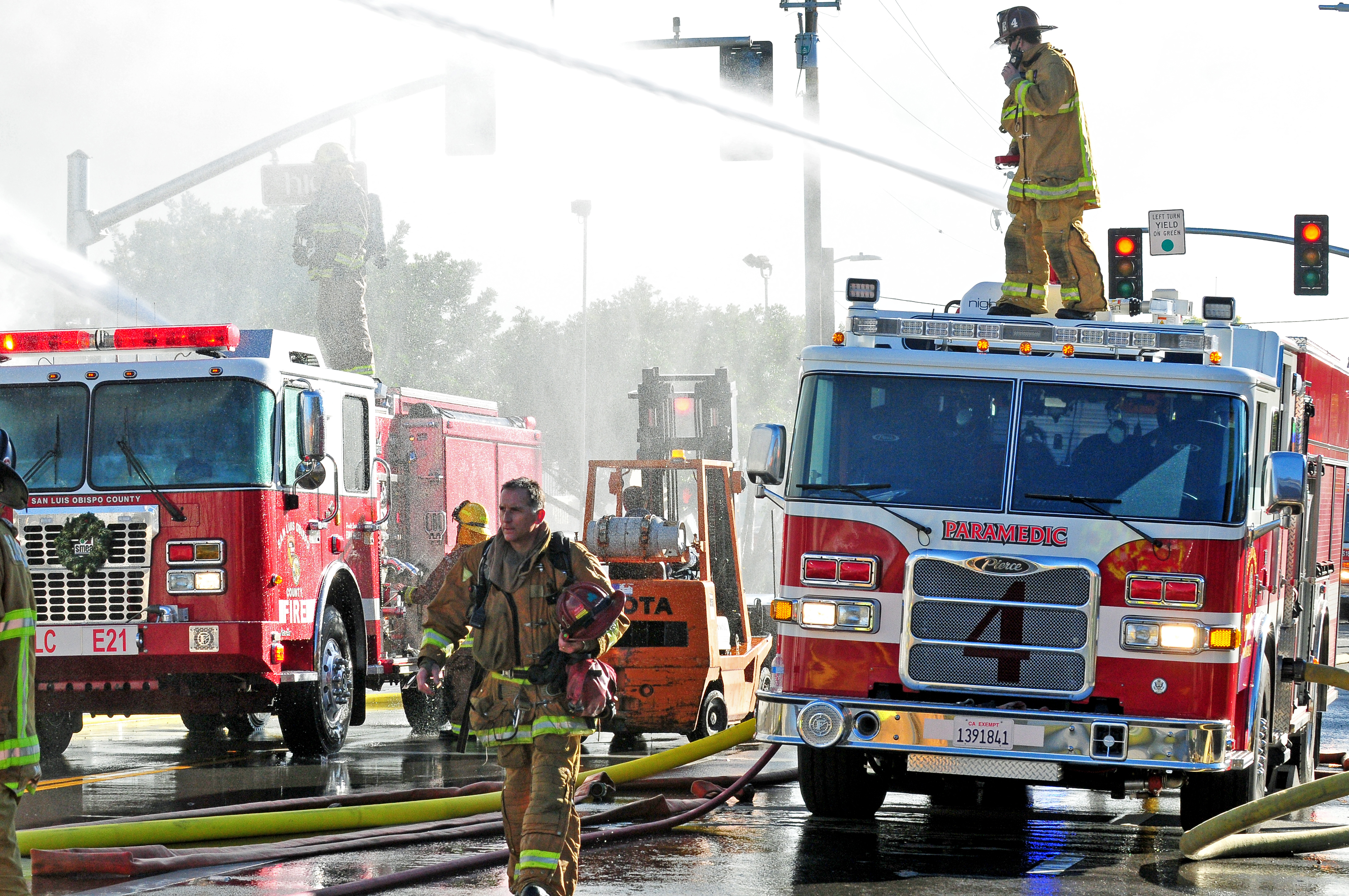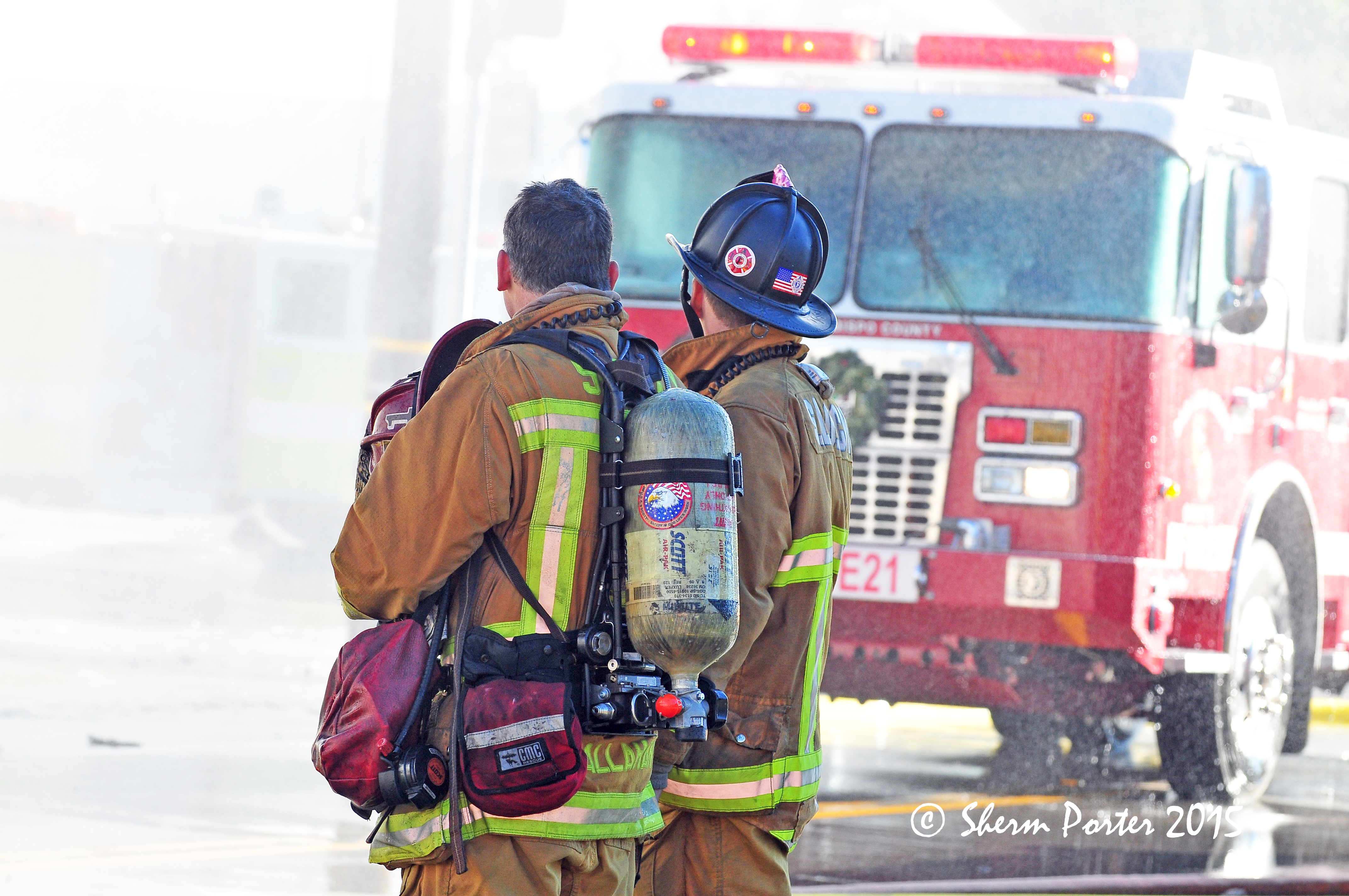The Sub Burndown
Saturday December 26, 2015
Section 1
- The Sub Fire -
Comments, Observations, & Corrections on Narrative Supplement of San Luis Obispo City Fire Department Captain Matt Callahan
Comments, Observations, & Corrections on Narrative Supplement of San Luis Obispo City Fire Department Captain Matt Callahan
Note: The address is 295 Higuera Street not 299 Higuera Street as stated by Callahan. However, Callahan parked ladder truck T-1 in front of 299 Higuera Street.
Narrative was not written immediately after the fire which is SLO City FD policy and the policy of all Fire Departments.
Captain Callahan's narrative does not have a date so we can assume it was written on January 4th or later. We can also assume he coordinated his narrative with others in violation of SLO City FD policy.
Callahan states Berryman told him to go onto roof and prepare for interior operations. Berryman told everyone else it was defensive only and made absolutely no preparation for an interior attack [see video: empty store front of The Sub - no firefighters staging]! Is Callahan "spinning" his story to justify the roof action or is BC-1 Berryman doing a "burndown"?
Callahan claims they cut a hole in The Sub's main roof and hot, pressurized smoke escaped - This is untrue. The roof louver above front of The Sub (at apex of first roof) did not close and was successfully venting the fire [see video: fire tail & white smoke]. Callahan watched this fire tail with his two associates before cutting open the attic hatch. Ample videos at this time show only white and light gray smoke. There would be no need to cut a hole when the louver on the end of the front room roof was in plain sight venting out and over the roof in the front of The Sub [see video: firemen on The Sub roof - hole/no black smoke]. Callahan does not mention that he (or his associates) upon arriving on The Sub roof also cut open the roof access hatch to successfully vent the fire as well - With both roof vents and hatch open the fire was venting perfectly for a coordinated interior attack.
We are to believe that firefighters who were too afraid to EVER go into The Sub to fight the fire were brave enough to cut a hole in a roof they feel is burning beneath them - Not a chance! Even the ventilation manual states the best practice is to cut a hole as close to and in front of the fire line as possible. They did this when they cut open the attic access hatch. They did the opposite when they next cut a huge hole eight feet from the far corner away from the fire, 40' from the fire line. This would have drawn the fire to this corner and spread the fire, not ventilated the fire.
Since it was declared a defensive fire, there was no reason to cut any holes in a roof as no interior attack was allowed, planned, or ever considered.
Callahan's description of his actions on the fire is not complete. Callahan states he could see active fire above the roof on Side A. Other than the fire tail coming from the open louver in the peak of the roof over the front room in The Sub, there was no fire on roof when Callahan arrived [see video: roof & white smoke before unknown incendiary device #2]. He does not mention when he first got on the roof, it was not there. It appears after Callahan arrives on the roof. We believe Callahan and associate added a flammable agent to our roof. Thirty seconds after they leave this area, a new roof fire starts on top of the roof and in 90 seconds it's fully going (unknown incendiary device #2). It is an incendiary device intentionally lit on our roof that Matt Callahan is describing. It only lasts four minutes before it is quickly washed down the scupper. It clearly is not burning through the roof. Callahan's statement pretends this was part of the fire rather than an intentionally set incendiary device to make the fire look bigger and more developed than it actually was. This second unknown incendiary was lit only four minutes after the window box fire was put out and within two minutes after Callahan arrived on the roof (and only 12 minutes into the fire). There was no time to burn through a one-hour rated roof in a dead corner 30 feet from the original unknown incendiary device in the window box. This incendiary took advance planning.
This second unknown incendiary device appears at 11:05am from nowhere and is totally gone by 11:09am! No hole in our roof but it did burn the thermoplastic polyolefin (TPO) roofing and the plywood on the parapet wall next to the firebomb. This is one of the only spots the vertical TPO completely burned through. It is also the exact spot the videos show Callahan and associates doing "something" 30 seconds prior to the roof incendiary ignition [see video: fire crew on roof]. Much of the roof in the corner survived the fire, showing that whatever was burning so huge (it looked just like our front windows) and so violently was on top of our roof and not coming through it. Callahan does not mention that the roof fire is gone five minutes after it started or that it was only a temporary roof fire at all.
Both the roof incendiary and initial window box fires show color indicating the temperature was at least 2700º F - way too high for the wood burning. They also both show black incendiary agent-type smoke initially.
At this point in the fire, stating that a high volume of heavy, black smoke came out of The Sub's main roof is hard to believe. All the videos show a well-venting fire with no black smoke [see video: venting fire]. It is easy to see into the store through the front door and easy to see the merchandise burning to the right all the way into the shop [see video: into shop]. No signs of heavy, black smoke anywhere at this time. Videos of firefighters on the roof cutting the huge hole do not show the smoke described by Callahan [see video: firefighter on The Sub roof by hole]. There is no dark smoke until the fire hose goes through the front door and the overhead master streams go through the 8'x8' hole that was cut in The Sub's roof which added massive amounts of oxygen and air to the fire pushing smoke out the front windows of The Sub for the first time.
Section 2
- Square Deal Recordings & Supplies (SDRS) Fire -
Section 3
- San Luis Obispo City Fire Department (SLO City FD) Issues -

Callahan also states black pressurized smoke was coming out of roof vents. The Sub's roof had NO roof vents - A sealed thermoplastic roof with no openings except the two louvers at the ends of the peaked roof which are clearly venting white smoke at the time of Callahan's claim [see video: white smoke venting at beginning of fire].
Callahan claiming he cut vent holes 40 feet from the seat of the fire (which was The Sub's window box) to slow the lateral motion of the fire along the roof is the opposite of the truth. The only reason to put vent holes that far from the seat of the fire is to draw it further into the building and increase the lateral spread, duh.
Callahan leaves out some key details in his description of the roof he cut through:
- He did cut two small triangle roof holes [see photo: holes] but did not mention that he also cut a huge 8-foot by 8-foot hole on the back side of The Sub's main roof (east end), opposite and as far from the seat of the fire as possible [see photo: smoke coming from newly cut hole at 11:07am].
- There is no attic! It is one large open display room with the bottom of all roof surfaces visible from below - [see Google virtual tour: Take the Google store tour to see for yourself].
- The roof was actually a 2'x8' rafter (not 2'x4'), then rough cut 1'x8', then ½" plywood, then concrete-type fireboard, then polyolefin plastic membrane - Was he guessing about the roof rather than actually seeing its construction as claimed??
Callahan then claims he cut three 3'x4' vent holes in Side A (facing Higuera Street in plain sight of the video-taking public that so far has found no images of the three holes) [see photo below: roof with no firefighter holes visible]. Callahan claims to cut three more times and that 10' flames shoot through all six of the holes - The videos of these six flame fountains would be interesting, if only there were any.
We do have evidence and video footage of Callahan cutting a 6-foot by 6-foot wide hole along the wall in front of The Sub. It acted as an air intake in the early part of the fire and a chimney later on.
- We do have evidence of the 4'x4' hole that was cut on the back side of The Sub's roof over the rear loft.
- We do have evidence of another 8'x8' draft hole cut over where the fire burned through the wall into Square Deal Recordings & Supplies.
The videos show no thick, black smoke filling the inside of The Sub. The videos show a Higuera-facing roof with no triangle cut holes and no flames spouting 10' into the air contrary to Callahan's statement.
At this point, The Sub's main building roof was still not significantly on fire contrary to Callahan's false claim.
After firemen cut the huge 8'x8' hole, Vasquez put the fire hose through the front door (which was acting as an intake vent) and two ladder trucks each directed a huge master water stream from overhead through other holes Callahan and crew had cut - This added massive oxygen to the fire to further burn the underside of the roof. It did nothing to fight the fire burning on the underside of the roof.
Callahan states when he came down from the roof, they kept all firefighters away from The Sub out of fear. He claims a large stucco wall/sign tower fell interior. (The sign tower was finally knocked into the front room over two hours later by fire hose master stream - No danger at this time.) No soffit fell for over two hours and would not have fallen at all except SLO City FD leadership intentionally refused to put water on the inside of the wall from the aerial trucks. This allowed the fire to burn through and eventually it failed - but it took over two hours! All parapet walls had just been earthquake retrofitted something BC-1 Berryman and Chief Olson had been informed of and none failed. Firefighters did come down at this time but returned to the roof and continued to cut many more holes in the apartment roof and then in the Square Deal roof.
Callahan then states Captain Vasquez came up the ladder and told them to get off the roof - Vasquez, who was in the front of The Sub (just having put the water hose through the front door), does not use his radio to warn the men who are on the roof. Instead, he walks to the corner, climbs the ladder, and goes across the Square Deal roof to The Sub roof to tell them to get down. This act would take him almost five minutes to accomplish. Considering what he thinks was an immediate danger, he would have used his radio and not wasted the time. Nice story told in unison by all - It makes no logical safety sense. Not talking on the radio about things they are not supposed to do does make sense. The firemen do come down but only after they cut another 8'x8' hole in The Sub roof 40 feet southwest of the first large hole they had cut. They cut another 4'x6' hole over the 100 Pismo Street door, another 6'x6' hole along the front Higuera Street wall of The Sub.
There is next an almost two-hour jump in time the Callahan narrative does not mention.
Although Callahan says he is to get off the roof, he returns and continues to cut multiple air draft holes ahead of the fire to keep it moving. Videos show Callahan and crew do not permanently leave the Square Deal roof until just before the front of Square Deal explodes into huge flames through the holes they cut into Square Deal roof. Why aren't these actions mentioned in the narratives? Callahan does not mention that he, Firefighter Renner, and Firefighter Hicks, just before the front of Square Deal explodes in flames, cut a 4-foot by 4-foot hole and a 2-foot by 6-foot hole in the southeasternmost corner of the Square Deal main roof to draw the fire all the way across the back of Square Deal [see photo: firefighters cutting
While they are doing this, only light white smoke (under no pressure) oozes from the cuts. They are cutting a drafting hole to draw the fire through Square Deal BEFORE the fire is in the front of Square Deal or fully in the back of Square Deal. They cut holes on both sides of Square Deal interior firewall when no fire was yet in the Square Deal main building, and a large hole on the crest of the Square Deal roof opposite these two holes [see photo above: fireman cutting hole].
They also cut two other large holes and three small holes in the east main roof of Square Deal way before the fire came into Square Deal. Photos of water streams going through the hole or fire coming out of the holes confirm their existence [see video: water & fire].
Later, Callahan comments pressurized smoke was in the attic at Square Deal. We do not have an attic - only big open space with the underside of the roof visible from below. There was no pressurized smoke at this time [see video: no pressurized smoke].

Callahan states that King was inside 303 Higuera Street and reported smoke. There was light smoke in 303 Higuera Street from 10:55am on - Going onto the roof to see if a fire was burning that had been burning on the underside of the roof of the adjoining building is NOT how you would track a fire burning interior. Callahan did not take the thermal camera with him so how could he tell? If King was actually inside 303 Higuera Street, he would be the one to see fire IF it was in 303 Higuera Street.
Callahan claiming his initial cut yielded pressurized smoke is not true. For pressurized smoke to exist there would have to be major fire inside 303 Higuera Street. King, who claimed to be in the interior, would have surely noticed!
Callahan claims he cut three vent holes to let the heat out to protect interior action - but in a defensive fire, there is no interior action. In our fire, no interior action was ever considered. Callahan actually cuts an 8'x8' hole over where the fire was restarted in 303 Higuera Street. He cuts four more at rear of 303 Higuera Street on both sides of the firewall he claims to have seen from the roof - (You can only see it from the roof if you cut a big hole through the roof). He also cuts four more holes along 303 Higuera Street roof on 'B' side - At least eight draft holes are cut to burn down the structure.
E2 Captain King (Division B) then pretends that somehow the fire came through the portal, through The Sub office, and into Square Deal. This IS the scenario Richard Ferris (owner) described to Battalion Chief 1 Berryman at the beginning of the fire. Ferris asked him to defend this opening and explained to him it was the only way the fire could get into the front of Square Deal.
BC-1 Berryman refused to defend either of the two breaches in our firewall.
So it's no surprise that Callahan and other SLO City FD narratives pretend this is what happened. Clear and indisputable evidence still at the scene proves this is not what happened because the fire did not come into the front of Square Deal from The Sub through The Sub office, as the office was never involved in the fire! It required either "magic" or someone to start a new fire in the front of Square Deal.
When the fire was started in the front of Square Deal, it was already completely out in The Sub along the adjoining wall.
Without the intentional lighting of the fire in three locations in the front of Square Deal, it would have taken a very, very long time to burn forward into Square Deal against prevailing wind and through the firewall 20 feet from the rear of Square Deal inside of the main building.
It would have been embarrassing to folks who had decided not to fight the fire, probably before they even arrived, and then actually escalated the situation - folks who, we believe, are operating illegally with an unpublished secret policy of not entering any structure where the fire is inside the structure. (If it's on fire inside the structure, we don't go in - it's dangerous - SLO City FD leadership underground policy.)
At the end of his narrative, Callahan talks about seeing through a hole in the attic floor to the first floor below - We have no attic spaces but do have a space above the two refrigerator rooms in the side wing of Square Deal. The only way Callahan could see this was when he cut another large hole in the roof above the cassette room and then through the top of the refrigerator ceiling to draft the fire up and through! He does acknowledge that he knows driving streams through the opening would spread the fire, but SLO City FD did drive streams through the openings!
Callahan states that not until the attic floor collapsed onto the main floor could they add water. Our building has no attic floors anywhere and, as it was, when the underside of a roof burns, putting water from above can never put out the active fire. It can wet and put out what has already burned but, mainly, it adds air to the existing underside of roof fire and causes it to spread and increase in intensity.
There is almost no narrative of the fire that burned for nine hours in Square Deal Recordings & Supplies. It's as if only The Sub was burned - yet, SLO City FD leadership had two hours to prepare a defense of Square Deal and only took actions to spread the fire instead of defend the property.
You cannot put out a fire burning only on the undersides of interior roofs from the outside and everyone knows this is a fact.
You cannot stop a fire from spreading to the adjoining building by creating drafts to suck the fire into the building and then refusing to take any defensive actions to stop the fire.
Firefighter Rules And Guidelines
The basis for the comments in this writing is taken from Firefighter's Rules of Engagement, the San Francisco Fire Department Ventilation Manual, and San Luis Obispo City Fire Emergency Operations Manual. These are standards that SLO City FD supposedly uses.
Section 4
- Comments, Observations and Correction on Narratives by SLO City FD -
- Section 1 - The Sub Fire:
- 6 Minutes With The Arsonist
- Full Fire Investigation Never Done - Arson Investigation Refused
- Clearing The Building - Checking to Make Sure No One is Inside
- No R.I.T. or F.A.S.T. Crew Assigned
- The Sub Fire Load & Interior Details
- The Sub Roof Details
- Seven Path to Enter & Fight the Fire at The Sub
- Intentionally Assisting In Burning a Building Down is Not Firefighting
- UID #2 on Top of The Sub Roof Corner A/B
- See How the Fire Moved Through the Structures
- Section 2: Square Deal Recordings & Supplies Fire:
- The Sub Office Proves Fire Did Not Come Into The Front Of Square Deal Recordings & Supplies From The Sub Through The Firewall Between The Two Businesses
- Unknown Incendiary Device Number Three
- SDRS Fire Load Notes
- 11 Basic Stop Points for Preventing Fire Spread into SDRS from Rear
- Hole Map Illustration
- Section 3: San Luis Obispo City Fire Department (SLO City FD) Issues:
- SLOFD Fire Calls 2009-2016
- SLOFD Press Release Corrections
- Bravest Act or a Cowardly, Evil Act?
- Is BC-1 Berryman An Arsonist?
- Total Destruction is a Job Well Done
- SLOFD Fails to Follow Its Own Rules
- SLOFD Underground "Burndown" Policy
- Is SLO City FD a Corrupt Fire Department?
- How Can You Believe A Fire Department Would Help Burn A Building Rather Than Save It?
- Official CityGate Report Shows Major Fire Department Problems that City Leadership Continues to Ignore
- They Train For What They Actually Do, BURN Things Down Fast and Efficiently
- Is SLO City FD a Corrupt Fire Department?
- Letter From City Manager Derek Johnson - June 12, 2018
- Letter To City Manager Derek Johnson - July 26, 2018
- Letter From City Manager Derek Johnson - August 13, 2018
- Letter To City Manager Derek Johnson - August 17, 2018
- Letter To City Manager Derek Johnson - August 17, 2018 (#2)
- SLO City FD Actual Firefighter Strategy
- Official CityGate Report Shows Major Fire Department Problems that City Leadership Continues to Ignore
- They Train For What They Actually Do, BURN Things Down Fast and Efficiently
- Section 4: Comments, Observations, and Corrections to Narratives of SLOFD:
- SLO City Fire Department Continues to Fail Our City
- Narrative: Battalion Chief Neal Berryman
- Narrative: Deputy Chief Jeff Gater
- Narrative: Chief Garret Olson
- Narrative: Captain Michael King
- Narrative: Captain Mark Vasquez
- Narrative: Captain Matt Callahan
- Narrative: Captain Paramedic Station 3A David Marshall
- Section 5: Case Studies (Pattern of Conduct):
- Section 6: SLOFD Firefighter Narratives
- Section 7: SLOFD Fire Investigation Report
- Section 8: Arson Investigator /Expert Letters
- Section 9: Firefighting Info:
- Section 10: Original Unedited Video Material
- Section 11: Original Photographs and Images
- Cesar's Photos
- Ethan B.'s Photos
- Drones Images
- "Katie's Friend"s Photos
- Neighbor's Photos
- Jim M.'s Video
- Jimmy T.'s Video
- John I.'s Witness Videos
- KCOY Photos
- Logan C.'s Photos
- Michael H.'s Photos
- Nicole and Kjerstin's Photos
- Shar's Photos
- "PRR"'s Photos
- Sara S.'s Photos and Videos
- Final Report Videos
- Section 12: Actual Firefighting Action
- Section 13: What Real Ventilation Training Looks Like

